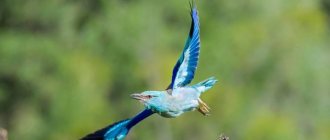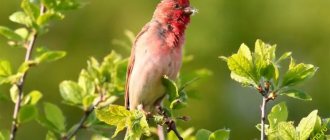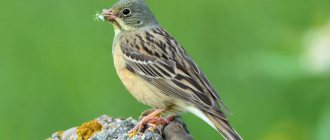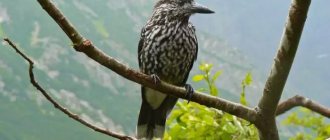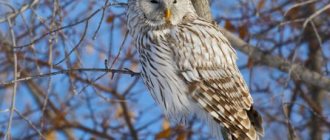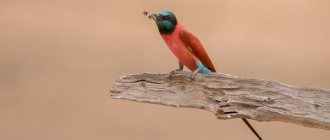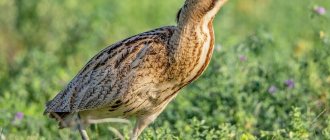The kookaburra or kookaburra is a very peculiar bird from the kingfisher family. The native range is considered to be the South-Eastern and Eastern parts of Australia. Subsequently, this bird was brought to New Guinea, Tasmania, New Zealand and it took root there perfectly. It is also called the giant kingfisher or the laughing kookaburra. These birds are divided into 4 subspecies of birds: laughing, blue-winged, red-bellied, Aruan. They have slight differences in size and color of plumage.
In the laughing kookaburra, the colors of the feathers are dominated by gray, brown and dirty white tones. Other relatives have blue, orange-red, and black plumage colors. Compared to the carcass, the head looks large and slightly crushed. The beak is massive, long and grows throughout their life. The eyes are dark, low-set, small with a hard look. And a short neck. The body length of these birds, depending on the species, is 35–65 cm. And they weigh from 300 to 500 grams. Let's take a look at the fascinating facts about this amazing bird.
REPRODUCTION
Kookaburras make nests in tree hollows. Sometimes it uses hollows carved by wood termites and cracks in the walls of houses for this purpose. The female lays 2-3 eggs.
For several months after birth, chicks are still completely dependent on their parents or their assistants. These are the chicks from the previous litter, which remain in the nest and help the parents feed the newborns and protect the territory of the settlement from predatory animals and birds.
An irritated kookaburra makes sounds that resemble laughter. She screams especially loudly in the evening. At this time, a loud chorus of bird voices is heard.
Kookaburra is a symbol of the Australian continent
The kookaburra is one of the national symbols of Australia along with the platypus and koala. The loud cry of the giant kingfisher is reminiscent of human laughter. Some people consider this laughter a good sign, but for others, wild laughter in the thicket of the forest is simply frightening.
The kookaburra always makes a deep impression on visitors to Australia.
But the kookaburra has nothing to do with it, nature simply gave the bird such a voice to protect its territory. Local residents attribute unusual qualities to the bird and strive to settle the cukuburra near their home. In Australia, the radio starts with the laughter of the kookaburra, setting a cheerful mood for the whole day across the Australian continent. The image of a laughing bird adorns Australian silver coins.
WHERE DOES IT LIVE?
There are two subspecies of this kingfisher. The first lives only in the forests of the northern state of Queensland, in Eastern Australia. Another subspecies is more widespread - it inhabits forests, grassy steppes, thickets and open spaces where trees are found. This subspecies breeds successfully on the island of Tasmania. The kookaburra settles in dense forests only in exceptional cases. Basically, it prefers open forests with thin-trunked trees covered with dense foliage. In such a forest there is enough grass and other vegetation, among which the kingfisher hunts, looking for the food it needs. These light forests, unlike Australia's dark and dense acacia forests, contain many species of trees. Such forests are found mainly in the north of the continent, and eucalyptus trees can still be found in them.
Interesting Facts
In its homeland, our bird, which has long been recognized as a symbol of this part of the world along with the kangaroo, echidna and platypus, enjoys extraordinary love and great popularity, and the laughter of the kookaburra serves as the call sign for radio broadcasting. Numerous facts indicate that the feathered creature we describe has attracted human attention from ancient times to the present day.
Here are some of them:
- The still ignorant Australian aborigines considered it a sin to offend the sacred winged creature and taught their children this from an early age, saying that they would grow rotten teeth if they touched the kookaburra;
- White settlers gave this bird the nickname “Laughing Hans.” And later, tourists traveling around the continent came up with a sign: if you hear the voice of a kookaburra, your wishes will come true and you will definitely be lucky;
- A laughing bird named Ollie became the mascot of the Summer Olympics, held in the oldest and largest city on the continent, Sydney;
- The fame of the Australian darling has crossed the borders of the small continent, and therefore her memorable voice is used in Disneyland during the attractions;
- The voice of a cheerful bird sounds in computer games, and also very often in the soundtracks of adventure films at moments when it is necessary to reflect the wild nature of the jungle in appropriate colors. All this is not surprising, because the furiously laughing night bird of the kookaburra simply cannot fail to impress.
Of the serious researchers, the first person to loudly tell the world about our representative of the feathered fauna was the Briton Jen Gould, an ornithologist of the 19th century, who published a most interesting book about Australian birds for her contemporaries. A good incentive for this were letters from his relatives who moved to a new continent at that time.
In their messages, the storytellers, sharing their impressions, also mentioned the kookaburra. They wrote that this bird not only has a wonderful voice, which they described with emotional admiration, but is extremely sociable and is not at all afraid of people.
On the contrary, the person, as they said, arouses her burning curiosity and desire to get closer in order to take a good look at this unusual object for her. But even before Gould, scientific descriptions of this bird had been given earlier. In particular, this was done at the end of the 18th century by Johann Hermann, a naturalist from France.
WHAT DOES IT EAT?
The kookaburra hunts during the daytime. Waits for prey sitting on a tree. The kookaburra feeds on crustaceans, snakes and, sometimes, the chicks of other birds. The kookaburra's hunting method is very simple, the main thing in it is patience and a lightning-fast attack. The kookaburra sits on a fairly high branch and waits for the desired prey to appear, for example, an insect, small amphibian, mammal or bird. Then she rushes down and grabs the prey with her strong long beak.
This hunting method is also typical for other members of the kingfisher family, which hunt fish in the same way. But the kookaburra does not fish - it prefers insects and small vertebrates. Australians love the kookaburra because it eats poisonous snakes.
Nutrition
These birds are active predators, and therefore, in addition to beautiful legends, they are covered with notoriety. There is talk of their extremely cruel behavior towards their feathered counterparts. Moreover, in such stories there is a lot of unnecessary things, but there is also truth. Indeed, kookaburras are capable of eating the chicks of relatives and other birds if there is a lack of other food.
They also hunt mice and other rodents. In rare cases, they are able to be seduced by small fish, however, they are not big fans of this kind of food. It is also true that the bulk of their diet consists of various types of reptiles, lizards, crustaceans, worms and insects, but not only.
And in killing prey, if it is many times larger than the bird itself, giant kingfishers are helped by a wide, powerful beak, pointed at the end. In their own interests, our laughing people are also capable of encroaching on the lives of their own kind, but they do this in exceptional circumstances.
Moreover, they themselves also often become victims of predators, mainly from the feathered community. The kookaburra bird also hunts poisonous snakes, for which it has become very famous. Therefore, in order to destroy creatures dangerous to humans, it is often deliberately bred in gardens and parks.
And a kookaburra’s attack on a snake happens like this. First, the brave hunter grabs the huge reptile from behind the head, from whose mouth a poisonous sting can appear at any moment, and holds it tightly by the neck. In such a situation, the enemy is unable to either harm his offender or resist him.
Then the winged hunter, taking off, throws his prey onto the rocks from a great height. Then he catches you by the neck again and again, lifts you up and throws you down. This continues until the victim is completely neutralized. Sometimes, for the final victory, the kookaburra has to finish off the snake by taking it in its beak, shaking it in the air and dragging it along the ground. And only after so much hard work finally comes time for lunch.
GENERAL PROVISIONS
In the morning, Australian radio call signs reproduce her scream. The local population loves this bird, so it has been settled in many areas of the country. The kookaburra is rarely found in zoos, although in captivity it lives a long time.
This is an arboreal bird that has adapted to life in the bush of Australia. One of the largest kingfishers, which is even called the giant kingfisher. Lives in eastern Australia. Body length up to 45 cm. Unlike the common kingfisher, the kookaburra is not at all associated with water. Her loud screams resemble laughter. At times, the kookaburra's cry is similar to the cry of a donkey. The main food is reptiles. The kookaburra especially often catches snakes. It also feeds on lizards, insects, and destroys bird nests.
Description and features
Of the currently inhabited continents, Australia was discovered later than others. This is a small southern continent that has been isolated from other parts of the land for millions of years. Therefore, the animal world of those places is famous for its originality and uniqueness.
But when Europeans began to explore these territories, of all the unusual creatures of those distant unexplored lands, most of all they paid attention to the wonderful jumping kangaroos and other numerous marsupials, as well as to the original bird, which was later given the nickname kookaburra .
The mentioned feathered creature is of average size and weighs about half a kilogram. It is endowed with a stocky, dense physique; a large, seemingly flattened head with small, round, low-set eyes; long, powerful, cone-shaped beak; motley plumage.
Australian Aborigines considered this winged creature sacred. Yes, the bird was so etched in the memory of the settlers that they wrote poems and funny songs about it, naturalists wrote lengthy reviews in their diaries, and its fame, despite the very small territory of the settlement, spread throughout the world.
Let us note right away that the attractiveness of such wild representatives of the feathered kingdom is not at all in their size, which usually does not exceed half a meter, or in the eye-pleasing shades of their feather outfit. The kookaburra's cry is unusual . It is he, like the voice of our rooster, that wakes up all the living creatures in the vicinity of their habitat in the morning.
This is the secret of charisma, as well as the name of this bird. And how can one not consider her special, even divine, since she announces to others the beginning of a new day? Yes, yes!
Australian roosters don't just crow. They laugh because the guttural sounds they make are reminiscent of expressive, exciting and joyful human laughter. The bird seems to rejoice at the next arrival of the life-giving luminary into the world. Residents of places where unusual birds are found have long believed that God commanded kookaburras to laugh from the time the sun rose over the earth for the first time.
Listen to the voice of the kookaburra
Thus, the Creator informed people about this significant event so that they would rush to admire the sunrise. Indigenous legends say that a new day cannot come until a kookaburra calls for it.
Her singing begins with low, clicking noises and ends with a shrill, heartbreaking laugh. Such a bird screams, not only foretelling the dawn, but also at the evening dawn. And her nightly laughter is so sinister and mysterious that it makes the heart freeze in superstitious trembling, because it comes to mind that this is how a gathering of evil spirits makes itself known.
The active voice of birds also serves as a harbinger of the onset of mating season. In normal times, it transmits information about the presence of individuals in a certain territory. Similar screams are often reproduced by our birds during hunting and attacking enemies, and then this battle cry sounds like a harbinger of death.
CHARACTERISTIC FEATURES OF THE KOOKABURA
Head and neck: the head is large, and the neck, like other kingfishers, is short.
Wings: Light blue feathers are visible on the upper side of the wings.
Beak: long, peaked, pointed and slightly flattened.
— Habitat of the kookaburra
WHERE DOES THE KOOKABURRA LIVE?
The population size of the laughing kingfisher (kookaburra) in its habitats - Australia and Tasmania - is quite large. The Blue-winged Kookaburra lives in the warmer areas of Northern Australia.
PROTECTION AND PRESERVATION
The kookaburra is not in danger of extinction, so it does not need protection. In Tasmania, the number of this species is constantly increasing.
External signs of a kookaburra
The kookaburra or laughing kingfisher is a very large bird, only slightly smaller in size than the king kingfisher. The birds have a second name - giant kingfishers.
Kookaburra (Dacelo).
The Kookaburra's plumage is dominated by off-white, gray and brown tones. The body length is 45–47 cm, and the average weight reaches 500 g.
Lifestyle
Ornithologists divide kookaburras into four species:
- laughing,
- red-bellied,
- blue-winged,
- Aruan.
The Laughing Kookaburra is divided into two subspecies: the Laughing Kookaburra and the Lesser Laughing Kookaburra.
Kookaburras gained popularity due to their ability to laugh like a human. They laugh contagiously and for a long time. During the day, such sounds make you smile, but at night, the cry of a bird makes your blood run cold.
Usually the ringleader is one kookaburra. But after the first sounds, the rest of her relatives join her, and the forest is filled with eerie laughter.
With such cries the birds warn each other of impending danger.
Kookaburras are sociable and prefer to live in groups. It is enough for several birds to laugh at the same time to scare away enemies. The birds work together to protect their area from enemies and fly in search of food.
In ancient times, Australians considered the laughing kookaburra a sacred bird. She loves to scream at dawn and before sunset, so the feathered bird is popularly called the “redneck alarm clock.”
With the help of an eerie laugh, kookaburras inform their relatives about the onset and end of the day. The birds go hunting before sunset and rest in the treetops at night.
The kookaburra became the symbol of Australia at the 2000 Olympics.
What does a bittern bird look like?
The bittern has black feathers with yellowish edges on its back, and its head is the same color. The belly is buffy with a brown transverse pattern. The tail is yellow-brown with a blackish pattern. In general, this coloring of the bittern is camouflage and helps the bird to remain unnoticed among the stems of reeds and reeds where it lives.
Interesting materials:
Where to point the NTV Plus satellite dish? Where does the comet's tail point at night? Where didn't this go? Where should iodine mesh not be applied? Somewhere through the dash? Where is this going? Somewhere or anywhere? Where to nowhere? Where should the pig be cut? Where to go if there is no electricity?
Keeping kookaburras in captivity
Kookaburras tolerate captivity conditions well and are kept in many zoos around the world. The birds quickly get used to people who bring food, recognize them among other zoo visitors and begin to laugh invitingly.
Kookaburras are famous for their calls, which are very similar to human laughter, hence the name of the birds.
And if the breadwinner enters the cage, the kookaburra sits on its shoulders, waiting for a portion of food. This behavior causes fear among those who are not familiar with its habits. A bird with a large beak digs in its claws to avoid falling and loudly demands food. Kookaburras are very noisy and active birds; they need spacious cages to fly and feel like they are in the forest.
7Facts about the kookaburra
- These birds sing before sunrise, at noon and before sunset. The performance begins with clucking noises and ends with loud laughter, heartbreaking and piercing.
- People who heard such a choir concert for the first time at night stand on end. There is a feeling that these sounds are coming from hell, where devils are tormenting sinners. My heart is literally trembling with fear.
- In fact, the kookaburra, using its extraordinary voice, is just protecting its territory. And in this way he warns of danger. This miracle also quarrels with its relatives.
- These birds are real predators. Birds feed on lizards, mice, insects and snakes, even the most poisonous ones. Laughing hunters eat only live food. And the victims are much larger than the trapper.
- Having tracked a resting viper, the kookaburra grabs it from the back of the neck just below the head. It takes off quickly and high with its prey and releases it into free flight, allowing it to break on the rocks. If the snake is still alive, the process is repeated.
- Kookaburras are monogamous. Having found a partner and created a couple with him, they live together all their lives. They jointly search for food, build a nest, incubate and raise chicks.
- These birds settle in the hollow of a eucalyptus tree, make it their home, and the female lays 2 to 4 eggs there. The incubation period lasts from 3 to 4 weeks. Babies are born naked, blind and helpless.
Kookaburra: natural enemies, population
These birds, once settled, live in one place for a long time. They are not afraid of people and are very curious. Kookaburras can fly up to campfires lit by tourists. They watch with interest how people set up a tent and settle down to rest. There the birds look for leftover food and can steal something. Kookaburras adapt well to captivity and quickly remember the people who care for them. When birds have a desire to get to know a person better, their eagerness can frighten them. Because such a miracle in feathers, up to half a meter in size, with a huge beak and laughing loudly, tries, as if in a friendly manner, to sit on his shoulder and grab him with its claws.
There are many poisonous snakes in Australia and the kookaburra is very useful in the fight against them. After all, she knows how to famously deal with cold-blooded animals. And even when the birdie is not ready to fly, because she is simply lazy. She grabs the reptile and begins to swing it in different directions like a whip. Throwing it on the ground, it begins to peck at the victim with its beak. The kookaburra tortures the unfortunate viper like a maniac until it becomes something vague and formless. This is how the bird prepares delicious snake cutlets for itself and destroys pests. The natives treat these birds very carefully and do not mind at all if the bird settles somewhere nearby.
The article was read by 3,639


